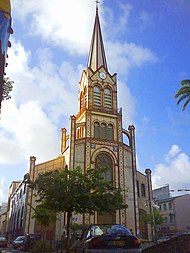Fort-de-France
| Fort-de-France | |
|---|---|

|

|
| Collectivité territoriale unique | Martinique |
| Arrondissement | Fort-de-France (prefecture) |
| Community association | Center de la Martinique |
| Coordinates | 14 ° 36 ′ N , 61 ° 4 ′ W |
| height | 0-1,070 m |
| surface | 44.21 km 2 |
| Residents | 80,041 (January 1, 2017) |
| Population density | 1,810 inhabitants / km 2 |
| Post Code | 97200 and 97234 (Quartier de Balata) |
| INSEE code | 97209 |
| Website | www.fortdefrance.fr |
 Fort-de-France |
|
Fort-de-France [ fɔʀdəˈfʀɑ̃ːs ] is the capital of Martinique in France . With 80,041 inhabitants (as of January 1, 2017) it is also one of the largest cities in the Lesser Antilles .
history
As early as 1638, on the instructions of the first governor Jacques du Parquet, the foundations of a fortification were laid on a volcanic rock in the swamp for the glory of the king and to protect the wide bay. 1669 founded the port and place Fort-Royal ; however, the ships still had to be pulled ashore to unload.
In 1676, the Governor General Marquis de Bass-Castelmore moved his official residence from Saint-Pierre to the more strategically located bay of Fort-Royal. His successor, the Count of Blénac Charles de Bourbon, began to drain the swampy coastal strip by creating a wide drainage ditch in the area of what is now the Boulevard Général de Gaulle. As early as 1681 the place had grown so much that it was made the administrative capital. After the Seven Years' War , Capuchins were given permission to build both a boys' and a girls' school between what is now the town hall and the Palace of Justice.
During the French Revolution , the place was renamed Fort-la-République (or République-Ville ) for a short time in 1793 , but renamed Fort-Royal again in 1794. It was given its current name in 1807 by a personal decree of Napoleon . During the reign of King Louis-Philippe (1830-1848) the place was expanded considerably. The newly founded Compagnie Générale Transatlantique set up their coal stores here. In January 1839 Fort-de-France was almost completely destroyed by an earthquake, and in June 1890 a great fire raged. In August of the following year there was another severe cyclone.
In 1850 the bishopric of Martinique was established with its seat in Fort-de-France. In 1853 the bishopric was moved to Saint-Pierre . After the natural disaster of 1902, which almost completely destroyed Saint-Pierre, it was moved back to Fort-de-France. In 1967 the diocese was then elevated to the Archdiocese of Saint-Pierre et Fort-de-France .
After the then island capital of Saint-Pierre was completely destroyed by lava and ash dust in 1902 by the volcanic eruption of the Montagne Pelée , Fort-de-France quickly developed into the economic and cultural center of the island. The population doubled from 27,000 in 1902 in a period of around 25 years to 180,000 in 1985. Behind the city center, the working-class districts of Morne Pichevin, Sainte-Thérèse and Trénelle emerged. The better residential areas of Balata, Bellevue, Didier and Redoute can be found on the mountain slopes.
Fort-de-France is now one of the largest cities in the Caribbean. As the city is built on several hills, there are only a few main roads between the districts, which are regularly congested during rush hour. During strikes, they can easily be blocked by demonstrators.
Attractions
The city has a natural harbor, Fort Desaix from 1780, surrounded by Fort Tartenson and Fort Gerbault. There is also a monument in honor of the French Empress Joséphine, who was born in Martinique . Also worth seeing are the following buildings classified as Monument historique and under monument protection :
- the town hall of Fort-de-France
- the Saint-Louis Cathedral (1895), built under the direction of Pierre-Henry Picq
- the Bibliothèque Schœlcher (1886/93), also built under the architect Picq
traffic
Martinique International Airport is located near Le Lamentin in the Fort-de-France area (southeast of the city).
sons and daughters of the town
- Frantz Fanon (1925–1961), psychiatrist, writer and pioneer of decolonization
- Raymond Roy-Camille (1927–1994), orthopedist and traumatologist in Paris; Pioneer in spinal surgery
- Maurice Marie-Sainte (1928–2017), Archbishop of Saint-Pierre and Fort-de-France
- Henri Guédon (1944–2006), musician and visual artist
- Claude Sommier (1952–2009), jazz pianist and composer
- Gérard Janvion (* 1953), former football player (French national team)
- Georges Vestris (* 1959), basketball player
- Liliane Gaschet (* 1962), track and field athlete
- Lucien Jean-Baptiste (* 1964), actor and voice actor
- Jean-Philippe Nilor (* 1965), politician
- Joël Abati (* 1970), handball player
- Jérôme Jeannet (* 1977), sword fencer
- Fabrice Jeannet (* 1980), sword fencer
- Fabrice Calligny (* 1981), sprinter
- Phara Anacharsis (* 1983), athlete
- Steeven Langil (* 1988), football player
- Ludvy Vaillant (born 1995), athlete
climate
The climate in Fort-de-France is, as generally in Martinique, humid and tropical. The temperatures hardly fluctuate over the year, they are between 24 ° C in February and a little over 26 ° C in August and September. The lowest precipitation falls in March, the rainy season with precipitation of over 200 mm lasts from July to November.
| Fort-de-France | ||||||||||||||||||||||||||||||||||||||||||||||||
|---|---|---|---|---|---|---|---|---|---|---|---|---|---|---|---|---|---|---|---|---|---|---|---|---|---|---|---|---|---|---|---|---|---|---|---|---|---|---|---|---|---|---|---|---|---|---|---|---|
| Climate diagram | ||||||||||||||||||||||||||||||||||||||||||||||||
| ||||||||||||||||||||||||||||||||||||||||||||||||
|
Average monthly temperatures and rainfall for Fort-de-France
Source: wetterkontor.de
|
|||||||||||||||||||||||||||||||||||||||||||||||||||||||||||||||||||||||||||||||||||||||||||||||||||||||||||||||||||||||||||||||||||||||||||||||||||||||||||||||||||||||||||||||||||||||||||||||||||
